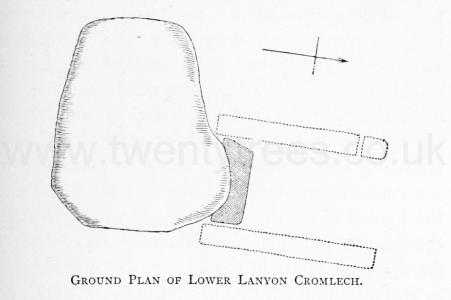Europe, British Isles, South-West England, Cornwall, Bosilack
Bosilack, Cornwall is in Cornwall.
Europe, British Isles, South-West England, Cornwall, Bosilack, Lanyon Quoit [Map]
Lanyon Quoit is also in South England West Burial Mounds.
Lanyon Quoit [Map].
Llewellynn Jewitt 1870. Researches which have been made in recent times show the absurdity of all this, and prove beyond doubt that the cromlechs are neither more nor less than sepulchral chambers denuded of their mounds. In several instances they have been found intact, and, these mounds being excavated, have been brought to light in a perfect state. These instances have occurred in Cornwall, in Derbyshire, and in other districts of England, as well as in the Channel Islands and elsewhere. One instance is that of the Lanyon cromlech [Map] in Cornwall. It seems that some seventy years ago "the farmer" to whom the ground belonged cast a longing eye on what appeared to be an immense heap of rich mould, and he resolved to cart it away and spread it over his fields. Accordingly he commenced operations, his men day after day digging away at the mound, and carting the soil off to the fields. By the time some hundred cart loads or so had been removed the men came to a large stone, which defied their efforts at removal, and, not knowing what it might be, or what it might lead to, they went on removing the surrounding earth, and gradually cleared, on all its sides, the majestic cromlech which is now one of the prides of Cornwall.
This highly interesting chamber contained a heap of broken urns and human bones. This "Lanyon cromlech," a view of which is given on fig. 37, consists now of three immense upright stones, on which rests an enormous capstone, measuring about eighteen and a half feet in length and about nine feet in width, and is computed to weigh above fifteen tons. How such stones were raised and placed on the rough upright stone supports which had been prepared for them is almost beyond comprehension, when it is recollected that they were raised by a people who were devoid of machinery.
"The heart,
Aching with thoughts of human littleness,
Asks, without hope of knowing, whose the strength
That poised thee here."
This cromlech when first uncovered consisted of four upright stones, on which rested the capstone. In 1815, during a tremendous storm, the capstone and one of the supports were thrown down. In 1824 the capstone was replaced, under the superintendence of Lieut. Goldsmith, R.N., and at this time a piece was broken off at A. The fourth upright stone was not replaced, having been broken when thrown down. Fig. 37 shows the cromlech as replaced. Fig. 38 is a plan of it, showing the uprights and the capstone. The large outline is the capstone, the part marked A being the part broken off; the shaded parts are the present three uprights; and B the fourth upright, broken.
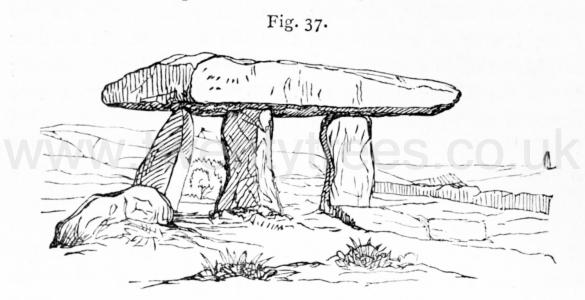
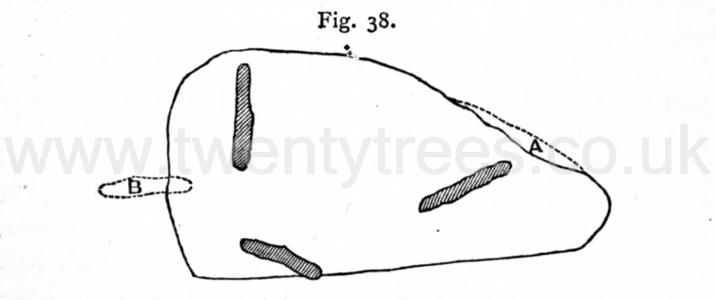
Nænia Cornubiæ by William Borlase Lanyon Cromlech. LANYON CROMLECH [Map]
This monument, as will be seen from the accompanying engraving taken from Borlase's Cornwall2, consisted, until its fall in the year 1815, of three slim pillars of unhewn granite, supporting on their summits a horizontal stone, at a sufficient height from the ground to permit a man mounted on horseback to sit under it. The cap stone, or "quoit," as it is termed in Cornwall, measured, (before a piece was broken off it), 47 feet in circumference, and averaged 20 inches thick. Viewed from the opposite hill, for it stands on high ground, the whole structure may not, even in its present stunted form1, be inaptly compared to a three-legged milking-stool. About the middle of the last century, a dream induced the owner of the property to dig beneath it, and directly under the "quoit" a simple grave was discovered, cut in the natural soil, without side stones or covering. At the depth of six feet the explorers reached the bottom; but unfortunately the other dimensions are not recorded. Although this pit was carefully searched on that occasion, and subsequently rifled more than once, Dr. Borlase assures us that nothing was found "more than ordinary." From this discovery, it seems quite clear that inhumation was the mode of burial practised in this case; for had cremation taken place, ashes, or at all events strata of burnt earth, would have been found; and it is only on the supposition that the corpse was laid unprotected in the porous ground, without any imperishable articles accompanying it, that the total absence of relics in the grave can be at all accounted for. Had the length of the cavity been recorded, some inference might have been formed as to the position in which the body was placed; that is whether it was extended at full length, or contracted, with the knees bent up towards the chin. Trivial as such a distinction may at first sight appear, it is just one of those points which, if carefully followed up, may one day become valuable to the ethnologist in distinguishing the lines of demarcation to be drawn between the various races or tribes inhabiting this country in the primitive era.
Note 2. The accuracy of the dimensions given in Borlase is fully borne out by a drawing of the same monument made by the late Canon Rogers, in 1797, eighteen years before its fall.
Note 1a. It was set up again in 1824, but several of the stones had been broken, and one of the supporters bears marks of recent cleavage. At present a person must stoop to pass under it.
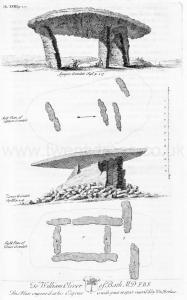
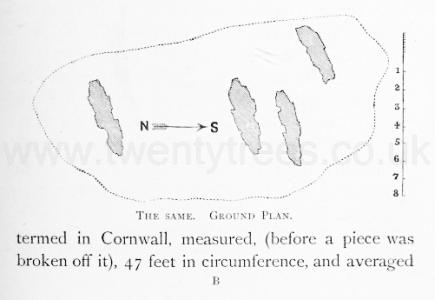
Nænia Cornubiæ by William Borlase Lanyon Cromlech. Two monuments of this kind are extant in Cornwall. They are situated within a mile or two of each other, and of the Lanyon Cromlech [Map], and both have been explored, the first by Dr. Borlase in the year 1752, and the second by the author in 1871.
Celtic, Druidical and Roman Remains. There are five of these ancient monuments in the west of Cornwall, all in a good state of preservation. The remains of one may be seen in a field about half-a-mile from the Lanyon cromlech [Map], and of another at Bosprennis, in Zennor [Map]. There are two other cromlechs beyond the limits of our inquiries, - one at Trevethy [Map], in St. Cleer, and another, now fallen, at Coit, in St. Columb.
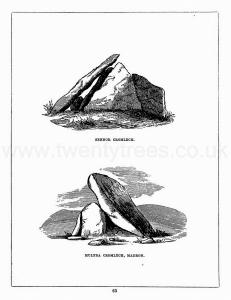
Celtic, Druidical and Roman Remains. The cover-stone of the Lanyon cromlech [Map] is 18½ feet long and 9 feet wide; from the under part of this stone to the ground it measures 5 feet. Borlase, and others who have followed him, state, that this cromlech is high enough for a man on horse back to pass under it. The Carwynen [Map] cromlech is less than that of Lanyon.
The Zennor cromlech is the largest in the county: the supporters are about 9 feet high, — the cover-stone, 18 feet long and 10½ feet wide.
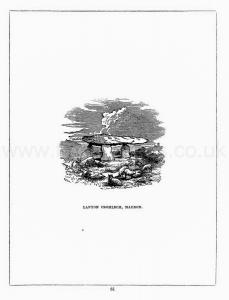
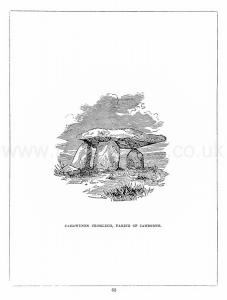
Europe, British Isles, South-West England, Cornwall, Bosilack, West aka Lower Lanyon Quoit [Map]
West aka Lower Lanyon Quoit is also in South England West Burial Mounds.
Nænia Cornubiæ by William Borlase Lower Lanyon Cromlech. Lower Lanyon Cromlech [Map].
The monument referred to is, curiously enough, situated on the same estate as the one lately described, namely, at Lanyon, in the parish of Madron; and is quite as good a specimen of the "Kist" type, as the former one was of the "Cromlech proper."
Two stones are all that now remain, viz., the covering stone, and one of the supporters; the others having been split up and carried away for building. A very rough sketch of this Cromlech, when perfect, will be found in Mr. Cotton's Illustrations of Antiquities in Cornwall, page 37; and the following notice of its discovery is preserved in the Archæologia, Vol. xiv, page 228.
"The gentleman who owns the estate of Lanyon, happening to be overtaken by a shower of rain in walking through his fields, took shelter behind a bank of earth and stones, and remarking that the earth was rich, he thought it might be useful for a compost. Accordingly, he sent his servants soon after to carry it off, when, having removed near a hundred cart loads, they observed the supporters of a Cromleh, from which the coverstone was slipped off on the south side, but still leaning against them. These supporters include a rectangular space open only at the north end, their dimensions being of a very extraordinary size, viz., that forming the eastern side ten feet and a half long, that on the west nine feet, with a small one added to complete the length of the other side, and the stone shutting up the south end about five feet wide. The cover-stone is about thirteen feet and a half, by ten feet and a half." "As soon as the gentleman observed it to be a Cromleh, he ordered his men to dig under it, where they soon ound a broken urn with many ashes, and going deeper they took up about half of a skull, the thigh bones, and most of the other bones of a human body, lying in a promiscuous state, and in such a disordered manner as fully proved that the grave had been opened before; and this is the more certain, because the flat stones which formed the grave, or what Dr. Borlase calls the Kist Vaen, and a flat stone, about six feet long, which probably lay at the bottom, had all been removed out of their places." The measurements of the covering stone given in this account quite accord with those taken by the author a short time since. In thickness it averages from one foot six, to one foot nine inches. It may be reasonably doubted if, from its present position, this stone was ever raised to the place for which it had been intended. Had such been the case, the mound would no doubt have served to consolidate the whole fabric, and to keep it in its place; and its present appearance leads to the conclusion that the builders, in this case, were never able to complete the stupendous work which they had begun. One of the displaced stones mentioned above may, perhaps, have served as the covering stone of the interment, in the absence of the one designed for that purpose.
The accompanying plan is an attempted restoration of this Cromlech (ist) from the stones as they now stand, (2nd) from the drawing by Mr. Colton, and (3rd) from the above account.
